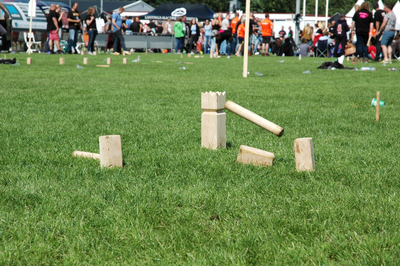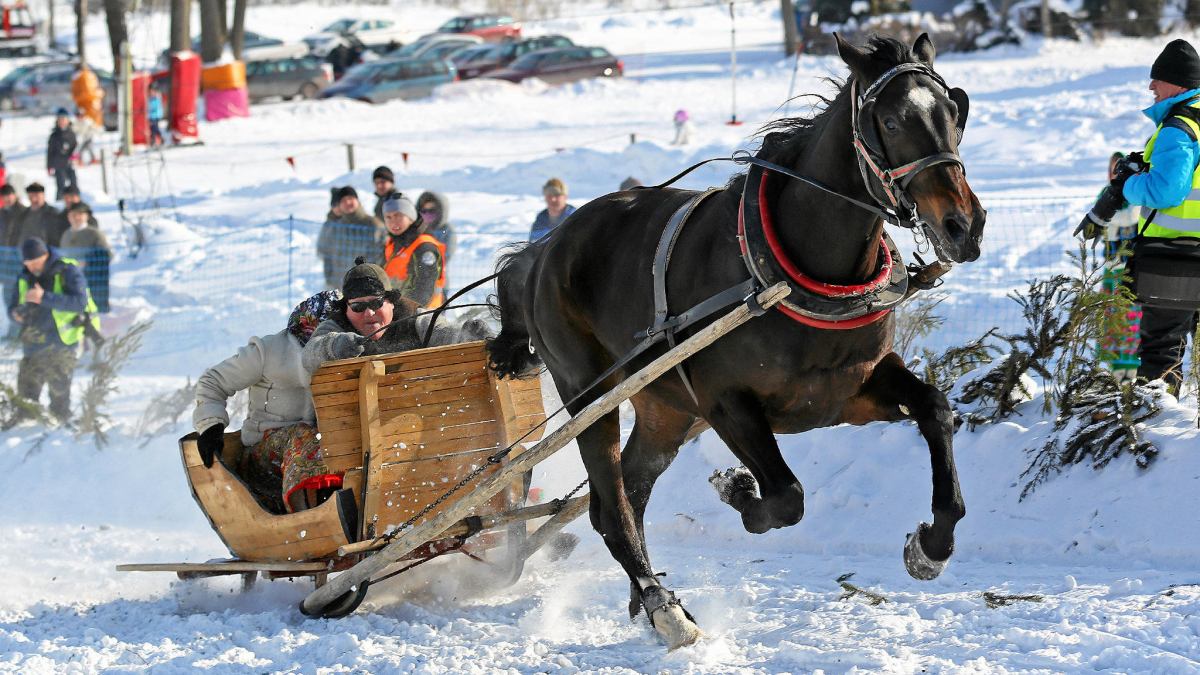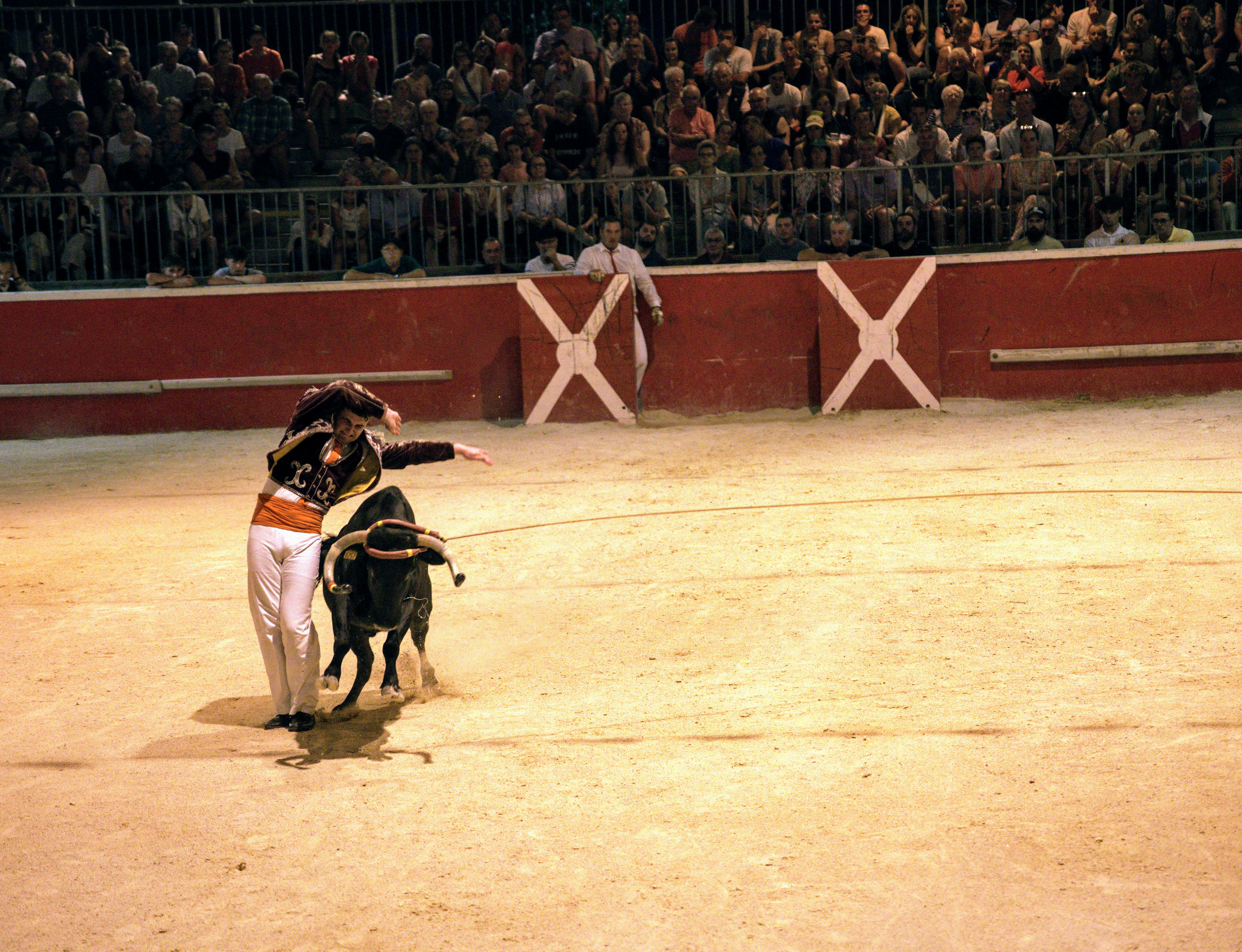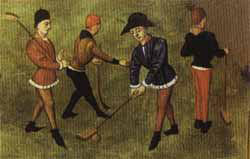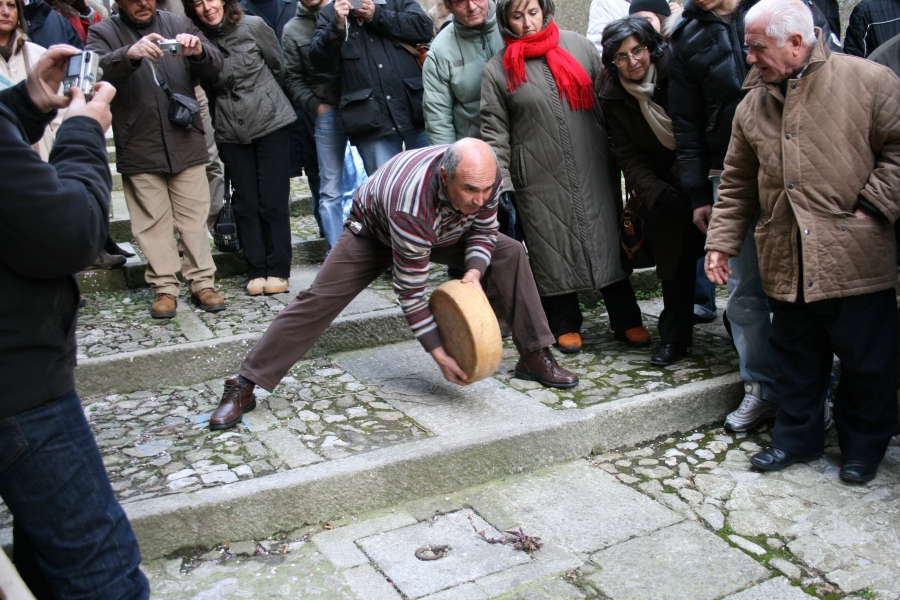- Name of sport (game): Kubb or viking chees
- Name in native language: Kubb
- Place of practice (continent, state, nation):
Sweden, France, USA, Belgium, Swiss
- History:
Source of information: https://kubbblog.wordpress.com/2016/10/06/kubb-history/#more-6
Kubb is often rumored to have been originated by Vikings during the Middle Ages. Allegedly, when the game was first created, it was played with bones instead of wooden pieces. The kubbs are said to be based off of the skulls of the enemies of the Vikings, and the batons based on the femur leg bone.
However, this is all a myth and has never been proven. The game’s first documented origins take place early in the 20th century in Scandinavia. It is based off of another lawn game called “Skittles” which is a variation of bowling.
The game began its modern era in Scandinavia in the early 1980’s when the first commercialized sets were manufactured as the game grew more popular. It is unclear when the game first came to America, but is thought to be sometime in the early to mid 2000’s. The first U.S. National Kubb Championship was held in Eau Claire, Wisconsin in 2007.
The game has spread through much of Wisconsin and somewhat into Minnesota primarily through traditional word of mouth. Friends and family who play the game and share with their friends and family etc. Small offshoots of the game can be found throughout the United States, but it has had the most success in being popular in the Upper Midwest. - Description:
Source of information: https://www.mastersofgames.com/rules/kubb-rules.htm
Equipment, Preparation and Terminology
The equipment consists of 10 small skittles (kubbs), one larger skittles (the king) and 6 throwing sticks. Sometimes 4 small corner stakes are also included to mark out the court. The best playing surfaces are grass or gravel.
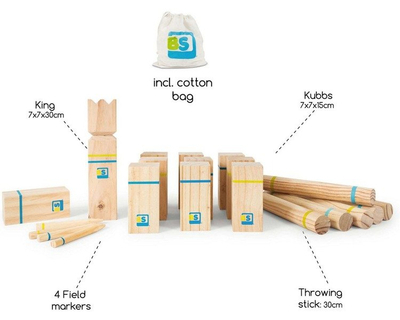
To begin, the playing court should be marked out. There is no standard size but here are 3 sizes that are often used:• 10 x 8m (33 x 26 feet)
• 10 x 5 m (33 x 26 feet)
• 8 x 5 m (26 x 16 feet)The most common size and the size used in the Kubb World Championships is 8 x 5m but this may make the game too difficult for beginners and children. Masters Traditional Games recommends using the following size to begin with - if you find it too easy, then increase the size. Younger children should perhaps start at 5 x 2 m.
6 x 3 m (20 x 10 feet)
The lines at either end of the court are called the "Baselines". The imaginary line parallel with the baselines through the middle of the court will be referred to as the "Middle Line".
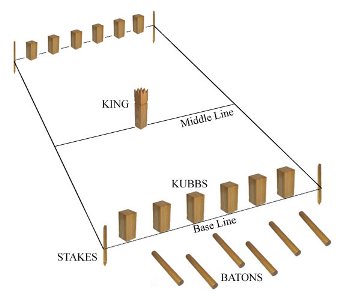
Place the king in the centre of the playing field, with 5 kubbs placed at regular intervals along each baseline - one at either end, one in the middle and the remaining two equi-distant between the first three.
Kubb is played by one team against another. A good number in each team is 1 or 2 players. However, for informal games, it really doesn't matter - up to 6 players can be in a team and it's even OK to have more people in one team than the other!
Kubbs standing in their starting position on the baseline are called "Baseline Kubbs". As part of the game, Kubbs are thrown into the middle of the playing field and are erected where they end up. These Kubbs are then called "Field Kubbs".To Begin
Sticks must always be thrown vertically and underarm. "Helicopter" throws are not allowed!
To decide which team starts, one person from each team throws a stick as close to the king as possible, but without hitting it. The team with the stick closest to the king starts.
For the first turn only, 4 sticks (not 6) are thrown from behind the baseline at the opponent's baseline Kubbs.Second and Subsequent Turns
Each turn (except the first) consists of potentially 4 phases.
When throwing at Kubbs, sticks must be thrown from behind the "throwing line" which just means from behind the Field Kubb closest to the opponent's side.
Put more technically, the Throwing Line is a line parallel with the baseline that passes through the nearest Kubb to the Middle Line on the player's side. Obviously, if there are no field Kubbs (because the opponents managed to topple every field Kubb during their turn), then the nearest Kubb to the King is on the baseline and so the throwing line IS the baseline.Phase 1 - Throwing the Kubbs
Players collect any Kubbs that were knocked over during the opponent's turn. These Kubbs are then thrown from the baseline into the opponents half of the court.
If a Kubb comes to rest outside the opponent's half of the court, players have one more chance to get it right - it must be retrieved and thrown again. If a Kubb fails to land in the required area for a second time, then the opponents can place the miscreant Kubb anywhere they like on their side of the court, although it must be at least one stick length away from the King.
In doing this, players are usually aiming to make the Kubbs land just beyond the middle line because the nearer the Kubbs are, the easier they are to topple in the next phase of the turn.Phase 2 - Field Kubbs
The next phase is to throw sticks at the opponents field Kubbs - i.e. the Kubbs that are not on the baseline. Players must throw from behind the Throwing Line (see above).
If a baseline Kubb is toppled before all the field Kubbs have been toppled, then the baseline Kubb is immediately returned to an upright position.
It is imperative that all Field Kubbs are toppled because otherwise, the opponents will be able to throw from a much closer point (behind the nearest Field Kubb instead of the Baseline) during their next turn. For that reason, a good strategy is to aim at the nearest Kubbs first - so that if any Field Kubbs are not toppled, at least the opponents will be as far away as possible.Phase 3 - Baseline Kubbs
If there are any sticks left over once all the field Kubbs in the opponents half have been toppled, the players then aim at the Kubbs on the baseline. Players must continue to throw from behind the Throwing Line (see above).Phase 4 - The King
If there are any sticks left over once all the Kubbs (field and baseline) on the opponents side have been toppled, then players may aim at the King. When throwing at the King, players must throw from behind the baseline.
When the team has thrown its 6 sticks, the turn passes back to the first team, and the entire procedure is repeated.Winning
If the King is knocked over by a thrown Kubb or by a stick before all the Kubbs on the opponent's side have been toppled, then the team that knocked it over loses and their opponents have won.
Otherwise, the game is won by the team that first topples all the sticks on the opponents half of the court and then topples the King from behind the baseline.
If the king is knocked over before all the kubbs have been knocked over, the opposing (non-throwing) team wins.Variants
The following rules are sometimes used but we feel that either they are not true to the spirit of the game, make the game too easy or make it overly complicated so do not recommend using them in general. However, the first two rules may be useful for young children or to reduce the length of games.
Some rules say that once a Kubb has been knocked over twice, it is removed from the field of play. This will have the effect of shortening the game considerably and so may be appropriate for younger children.
Another idea sometimes used is the "tower of Kubbs" rule when throwing toppled Kubbs back into the opponents half of the court. After a Kubb has been thrown and returned to the upright position in the opponent's half of the court, any subsequent Kubb thrown into the opponents half of the court that knocks it over is then placed ON TOP of the toppled Kubb. i.e. Both Kubbs are then placed in an upright, position, one on top of the other to form a tower. If a tower of 2 Kubbs is toppled by a third Kubb, then the three Kubbs are then placed in a tower - and so on. This rule also serves to make the game finish more quickly because often less sticks are needed to dispose of all the field Kubbs before moving on to the baseline Kubbs.
Some rules say that only one attempt at the King is allowed per turn. If any sticks are remaining after that, the turn ends, regardless.Another rule sometimes used says that players are only allowed to throw at the King if they have 2 or more sticks remaining. This will makes games take longer.
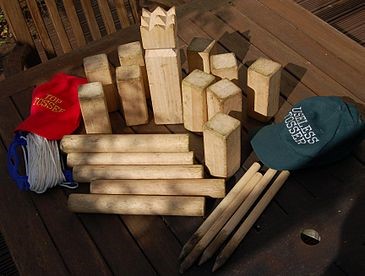
- Contacts:
European Kubb Association (EKA)
Fb: https://www.facebook.com/kubbeurope/
Webside: http://www.kubbeurope.com/
Email:This email address is being protected from spambots. You need JavaScript enabled to view it. 
Swiss Kubb Association
Webside: http://kubbtour.ch/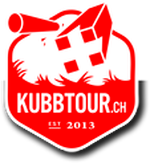
Belgian Kubb Association
Webside: https://www.kubbfederatie.be/
Deutscher Kubb-Bund e.V.
Fb: https://www.facebook.com/DeutscherKubbBund/
- Sources of information :
Articles:
https://kubbon.com/2018/03/07/new-kubb-tournament-rules/Video:
https://www.youtube.com/watch?v=rZ8Q2ZpHLdM
https://www.youtube.com/watch?v=XfWt0-_MNsY
https://www.youtube.com/watch?v=liMZ-dFMJSc - Gallery:
- Documents:
- Name of sport (game): Kumoterka Race
- Name in native language: Wyścigi kumoterek - Gońba
- Place of practice (continent, state, nation):
Podhale (Polish highlands), Poland (Szaflary, Ludźmierz, Biały Dunajec, Poronin, Kościelisko, Białka Tatrzańska, Bukowina Tatrzańska, Zakopane)
- History:
Kumoterka was first a means of transport. In the interwar period they lost its character. Then, in the years 1929-1939, shows consisted of Polish Highlands’ horse-drawn (Podhale) were organized. After the war, attempts were made to reactivate the horse-drawn cart competition during the Winter Festival in Zakopane. However, it was only in 1973 that races of kumoterki appeared in Podhale for good.
Kumoterki are small, woven or wooden, decorated sleigh. They are often masterpieces of woodcarving art, made of local wood species, decorated with openwork patterns and ash braid, straw or hay is placed on the seat and covered with a checked highlander horse blanket with fringes.
In the past, when the nearest church from Zakopane was in Szaflary, the godparents used such sleighs to transport the baby to the baptism of kumotr and kumoska (godparents of the child). The appearance of the sleigh was dictated by practical reasons, as Jan Pluciński recalls in "Spiszak's Childhood": "(...) the kumoterki were less subversive because they were without seats; you sat at the bottom of the sleigh and the bottom was closer to the ground. There was a bench attached to the back, on the skies, on which the carter stood and carried his weight in such a way to keep the balance and not to let fall over”. Balance with balance but accidents did happen and more than once a tiny Christian landed in a deep snowdrift.
Today, highlanders' christenings look similar to other parts of Poland, so over time, the kumoterki have lost their function. - Description:
Kumoterka- sleigh used for racing
Kumoterki- plular form of Kumoterka
Kumotr- male driver
Kumoska- female driver
Gazda- owner of rural farm, host
Gaździna- owner’s wife
Gońba- horse pursuitKumoterki races are run over different distances, generally from 400 to 800 meters (sometimes up to 1400 meters). The track is usually marked out on a horseshoe plan. It is important that a lot of bends appear. This is the best way to check that you have mastered the art of driving. The crowning achievement of the competition is preceded by a great “Kumoterska Gońba” parade held at the end of the Highlander Carnival in Bukowina Tatrzańska.
During the races wearing a colorful skirt and a leather jerkin, the kumoska sits in kumoterka. A gazda is driving. It would seem that mastering such a horse-drawn is not difficult. However, those who have not seen the races on their own eyes cannot imagine the speed at which these tiny sleighs are racing. The race is very dangerous, especially in the corners of the route being traveled. Participants must show great courage and the ability to drive (gazdowie) and balance (gaździny) to maintain the balance of the sleigh. The endurance of horses is also of great importance. Accidents are not uncommon, although they are usually monitored.
Both the organizers and participants attach great importance to the appearance. The jury not only evaluates the travel time measured with the photocell. What is also very important is the outfit of Kumotr and kumoska, the appearance of horses, harnesses and of course the kumoterka.
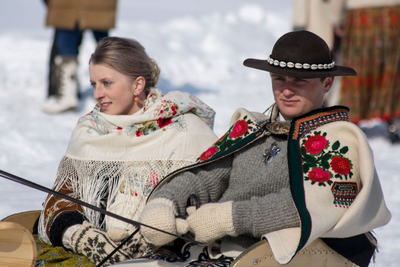
Parades and” kumoterskie gońby” are not only races with highlander sleighs. It is also a bold skiring and ski-skiring competition. Both women and men take part in these competitions. They race at a distance of not less than 400 m. In the skiring, the person following the skis must also drive, while in the ski-skiring the horse is driven by the rider and the skier behind them is trying to stay on his feet. Winning the competition is not easy at all and obtaining the title of champion in driving is associated with something more important for the highlanders than the award: with great respect and recognition of other competitors.
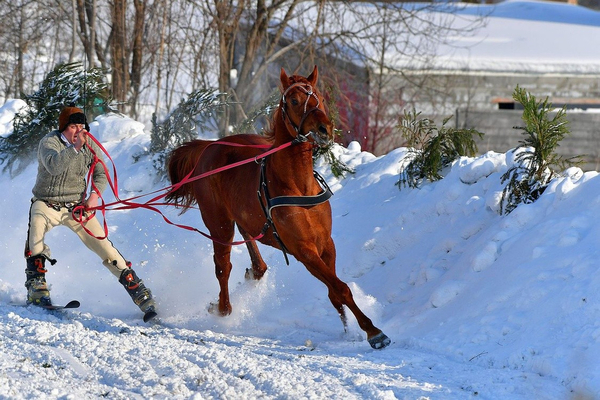
- Current status:
Races of kumoterki have been organized for many years. Even before the Second World War, races were organized in Zakopane. In modern times, the tradition resumed at the Highlander Carnival in Bukowina Tatrzańska, which was organized for the first time in 1973. Only 16 sleighs competed in the race of kumoterki. Since then, highlanders have been organizing chases every year and the number of participants has approached one hundred. The players represent almost every town in Podhale. The first “Gazd parade” took place in 1983.
These extremely colorful sports events often last a long time (even up to 2 months), gathering around them not only the majority of highlanders-horse riders but also a lot of tourists who rarely have the opportunity to meet highlanders having fun in a true highlander event. Each competition attracts crowds, even several thousand viewers. Today, in parades and chases, you can admire several dozen kumoterki and over a hundred skiring and ski-skiring competitors. - Importance (for practitioners, communities etc.):
Kumoterka races are an opportunity to meet and especially to cultivate the Podhale (Polish highland) tradition. Participants - gazdowie and gaźdźiny (hosts and housewives in the Podhale language) are festively dressed, horses wear decorations and the whole ceremony attracts viewers from many places in Poland and abroad.
Gońba Kumoterska was entered in 2017 on the national list of intangible cultural heritage in Poland. - Sources of information :
Articles:
https://www.kumoterki.pl/
https://www.zakopane.info/wyscigi-kumoterek-zdjecia/
http://www.tatramagazine.pl/kultura-i-sztuka/242-gonba-kumoterskaVideo:
https://www.youtube.com/watch?v=VgIJG9EKNho
https://www.youtube.com/watch?v=C0N2X_AU4Zw - Gallery:
- Name of sport (game): Kureş
- Name in native language: Kureş
- Place of practice (continent, state, nation):
Romania (Dobrudgea)
- Description:
Kures is played on grass, with music, outdoor, during summer festivals.It is a standing up wrestling style with clothes.
The wrestlers wear a T-Shirt and a short. Legs can grip legs. The arm position is fixed with hands gripping in a tight belt. No weight categories. Tricks are mainly with hips and legs. Victory is given when a wrestler is thrown clearly on his back (flat back).
- Name of sport (game): La course camarguaise
- Place of practice (continent, state, nation):
France
- History:
The Camargue race is a sporting and cultural practice, designed to highlight the fighting spirit and intelligence of the Camargue bull, called «biòu». In the arenas, located in the heart of villages, men dressed in white, the shavers will try to graze, to shave the biòu as close as possible, in order to unhook the fixed attributes such as the roundel. Unlike bullfighting in Spain and bullfighting, the Camargue race takes place without killing, and it is the bull that is a star, not the man. The oldest testimony of the origin of the Camargue race goes back to 1402 in Arles: a race was given in honour of Louis II, Count of Provence.
- Description:
From spring through to autumn, on the golden sand of Arles' arena and in each Camargue village, an impassioned and knowledgeable crowd is gathered. Razeteurs (Camargue bullfighters) come head-to-head with Camargue bulls in this chivalrous game that requires such values as loyalty and valour from both Man and beast. Skill and agility, along with a mutual re-spect, are key to the Camargue bullfight. Unlike with corridas (Spanish bullfights) which show the matador's name in big letters, post-ers publicising the course Camarguaise puts the bull's name before that of the razeteur. The name of the manade (farm) from which the bull comes is also given. The true star of the show is really the bull! From fight to fight, his qualities bring him glory and make him a sought-after animal, guaranteeing some very action-packed afternoons! As for the razeteurs, they are just support acts, their fame being based on the reputation of the bull that they are facing. No blood is spilled in the Camargue bullfight; the Camargue bull does not come to kill, unlike his Spanish cousin. When this bull kills, which unfortunately can happen, his name is scratched from all lists.
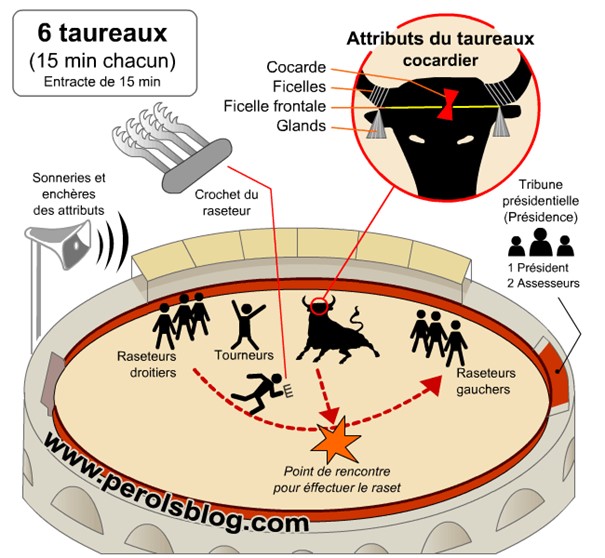
Source: https://www.manade-caillan.fr/nos-courses-camarguaises - Current status:
On 10 October 1975, the French Federation of Camargue Racing (FFCC) was approved by the French Ministry of Youth, Sports and Community Life. Camargue racing is recognized as a sport by the State Secretariat for Youth and Sports.
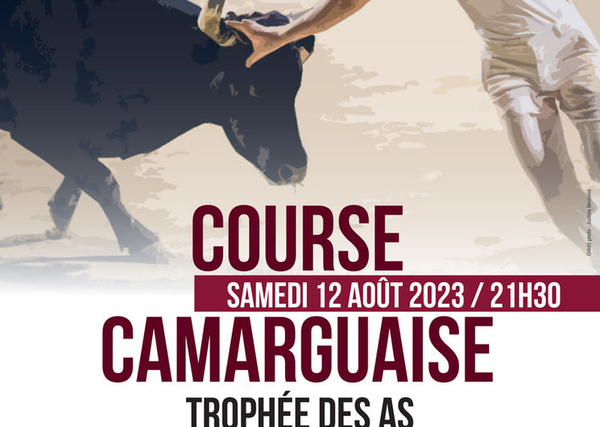
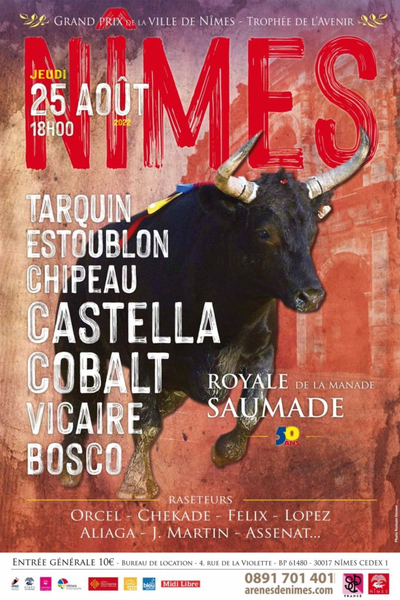
- Importance (for practitioners, communities etc.):
The Camargue race (or free race) is a sporting, cultural and traditional practice which attracts more than 300,000 spectators to the arenas each year and has more than 3500 licensees. Approximately 850 races are organized each year during the season. The championship is organized into three trophies according to the level of the shavers: the Trophy of Aces, the Trophy of the Future, and the Trophy of Honor.
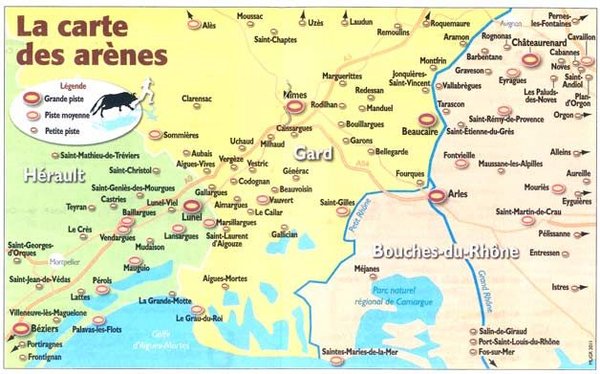
Source: https://www.domainegassier.com/en/2011/07/28/an-afternoon-at-a-course-camarguaise-part-i/ - Contacts:
Fédération Française de la Course Camarguaise
485 rue Aimé Orand, Nîmes, France
E-mail:This email address is being protected from spambots. You need JavaScript enabled to view it.
Web: https://www.ffcc.info/
Fb: https://www.facebook.com/federationfrancaisecoursecamarguaise/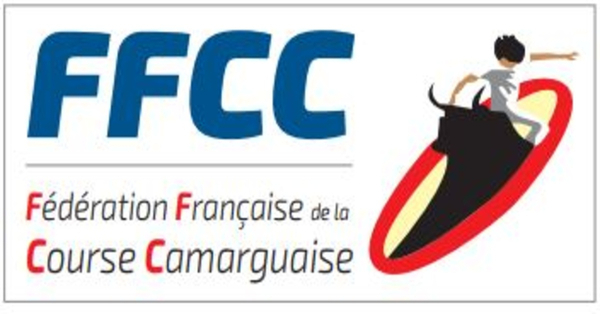
- Sources of information :
Books:
Ludovic Estevan, Course Camarguaise: Taureaux & cocardiers, Editions Equinoxe 2019
Éric Delaperrière, La course camarguaise, Editions Equinoxe 2004
Jacky Simeon, Dictionnaire de la course camarguaise, DIABLE VAUVERT, 2013
Christian Louis Sournia, La course camarguaise, Ecole nationale vétérinaire de Toulouse, 1984
William Greatfield, Lucie Subrero, Le taureau et la course camarguaise,
ERREUR PERIMES Delville, 1987Articles:
https://www.manade-caillan.fr/nos-courses-camarguaises
https://www.avignon-et-provence.com/en/traditions/course-camarguaise-camargue-bullfighting
https://www.arlestourisme.com/en/the-camargue-races.html
https://www.provence-camargue-tourisme.com/course-camarguaise
https://www.etudesheraultaises.fr/publi/la-course-camarguaise/
https://martinmiddlebrook.com/course-camarguaise
https://frenchstonesbook.com/?page_id=584
http://salonpatrimoineetchemins.fr/pages/print.php?title=la-bouvine-et-la-course-camarguaisePhotos:
Photos credits : Guillaume Lanouhe, Association Brev’ArtVideo:
https://www.youtube.com/watch?v=aDLd1rRqcUk
https://www.youtube.com/watch?v=irSQRbpd_pI
https://www.facebook.com/watch/?v=1007233787341624The information contained in the article comes from the following sources:
www.quelmastermarketing.fr/2021/10/11/la-course-camarguaise/#:~:text=La%20course%20camarguaise%20(ou%20course,compte%20plus%20de%203500%20licenciés.Source of photos used in this article and gallery:
Guillaume Lanouhe, Association Brev’Art - Gallery:
- Documents:
- Name of sport (game): la Course Landaise
- Name in native language: la Course Landaise
- Place of practice (continent, state, nation):
The six "départements" where the "courses" are practiced are Landes, Gers, some areas of the Pyrénées - Atlantiques, of the Hautes - Pyrénées, of Lot-et-Garonne and of Gironde. These cities have arenas and infrastructure required to organize the competitions. La Course Landaise is a sport belonging to the cultural heritage of Gascony (Gascon). Nowadays la Course Landaise, the traditional discipline of Gascony, is still main event at rural festivals. Its modern form comes from 1830.
- History:
The passion of the inhabitants of Gascony for cow racing is a long story. The document found in the Bayonne archives of 1289 is an evidence of this. Of course, it did not look like la Course Landaise we know today.
The first races included running on the narrow streets of medieval cities from animals that were led by butchers to the slaughterhouse. Cows, oxen and bulls gave young people some adventure in their life, like facing the horns, and at the same time opposing civil and religious authorities who severely condemned these, considered anarchist and pagan, practices.
Testimonies about the sport with cow racing have been reported for centuries in southwestern France. The oldest authentic document preserved in the National Archives (from 1457) refers to the old custom of running cows and oxen on the streets of Saint-Sever during Saint-Jean’s festival. Similarly, in the city of La Teste-de-Buch, the tradition was that the cows ran through the dunes, while the players tried to jump over the animals. It was practiced on sand and therefore it was less dangerous.
Course Landaise perfectly shows the culture of Gascony, the culture of popular holidays, courage and emotions. The public authorities, paradoxically, wanting to ban and then controlling the competition, imposing the first regulations and building the first arenas, have allowed la Course Landaise to develop and become popular tradition of the region. It was only in the 19th century that la Course Landaise’s form became organized. First of all, it had to be practiced in a limited and closed place, surrounded by the audience, and not freely on the street, as it was until then. The use of the rope and the role of the person responsible for this rope were already known at the end of the French Revolution and the acrobats were performing in this limited space of the arena. Among them the most known are:
- la feinte (deception) – created by Darracq brothers of Laurède in 1831,
- l'écart (dodge), made for the first time by Cizos in 1850,
- le saut (somersault), made for the first time by Charles Kroumir in 1886 in Peyrehorade
It should also be noted that at that time there were also other types of competitions involving cows or even bulls (e.g. stabbing a spear into the neck of a running animal). Throughout the 19th century this Gascon sport was called the Course de Taureaux "(or Course aux Taureaux). October 17th and 18th, 1852, is an important date when Iberian cattle appear in Magescq, which fitted more for the organization of competitions than the local cattle.
The arrival of Spanish bullfighting in France in the half of the 19th century meant the arrival of Spanish cattle, the birth of the first ganaderos, the first cuadrillas ... From now on brave contestants become bullfighters, accept their clothes from the light, with the accompany of music. It was during this time that the contestants (bullfighters) adopted the habit of wearing white trousers and colored bolero, decorated with gold or silver elements. There is also the habit of wrapping the ends of horns of the most dangerous animals.
In the 19th and 20th century many arenas were built, especially in the departments of Landes, Gers and Gironde. Today, la Course Landaise competition is held especially in Landes and Gers, where the season of this sport runs from March to October, as well as customary on the day of the patron. Still, the sport is practiced in several regions of the Atlantic Pyrenees, and even in the Hautes-Pyrenees, while the less popular sport is in Gironde. The arenas in La Teste and Arcachon were destroyed, and Bordeaux cultivated this tradition until the middle of the 20th century. Smaller events also take place in Floirac, La Brède and Captieux.
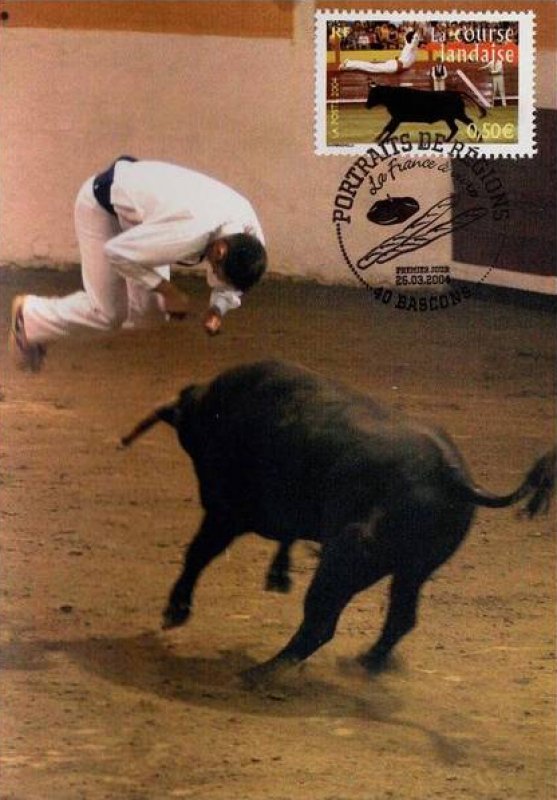
- Description:
This is one of the four forms of this type of fighting practiced in the world. It differs from the other three (corrida, Portuguese corrida and Camargue) by two special traits: firstly, it is practiced almost only with cows, not bulls. The second feature, which it shares with the Camarguaise breed, is that the animals are not killed during or after the race.
The bullfighters compete against the cows of the Spanish Brava and Toro de Lidia, which are called "Coursières", bred by Ganaderos in the Landes region – mainly between Dax and Aire-sur-l'Adour. Each farm has its own cuadrill or teams of bullfighters. It also has its own colors.
The bullfighters, locally known "Coursayres" in Gasconia, are divided into two categories:
- Les écarteurs are the basic characters in la Course Landaise and they are waiting for the cows in the arena. When the animals run out, contestants dodge at the last moment, thus avoiding collision. The dodge can be made "out", "inwards" (i.e. on the rope side/outside the rope keeper) or with a rope on the ground.
- Les sauteurs (jumpers) are waiting for a cow and jump over it. Animal’s path of running must be straight. These are, with rare exceptions, acrobats.
In the past, some outstanding athletes combined both these forms (i.e. dodging with jumps).
There are several types of dodges, but purists appreciate the dodging technique in which the horns of the animal pass around the bullfighter's kidney. The only training center for Course Landaise trainees is placed in Pomarez.
Cows, also called "courières", are female bulls fighting in the bullfight. Each of them has its own name. Before going to the arena, they are locked in boxes. They have rope attached around their horns to ensure safety during the fight in the arena. After the beginning of the competition, the cows come out in the pre-arranged order under the care of the person who leads them (Gascon courdayre) and two trainers. They place the animal in front of the bullfighter at the edge of the track, from where they start their run. Fifteen breeders (or ganaderos) raise 1,500 cows providing them freedom, more than half of which were born in the Landes region. Thanks to this, they are half a wild animal, which is very offensive. The most important breeders buy a hundred young cows in Spain every year, on farms in the Salamanca region, in order to complete their herd.
The cow goes out for the first time to the arena at the age of three or four and continues its career until it reaches the age of about thirteen. It can live longer than twenty years. It weighs from 300 to 400 kg (the weight of the bull is from 450 to 600 kg).
- Current status:
Today: practiced sport
Four types of Course Landaise:
1) Course formelle
This is a race that takes place throughout the whole season. This is where the reputation of people and cows is built. It takes about two hours and fifteen minutes, with a break, and it always starts with the Les écarteurs parade, ending with the March Cazérienne played on harmony. The music of the harmony then accompanies during the struggle.
In the season (temporada), five groups of breeders (ganaderías) and five teams of athletes (cuadrillas) take part in team and individual competitions. During the competition, the cuadrilla (team of athletes) consists of seven écarteurs wearing a bolero and four men dressed in white (jumper, two trainers and person from the rope service). This type of competition takes place mainly in Chalosse, Tursan, Armagnac, North Béarn and Bigorre.
At least ten cows participate in competitions. They are locked in boxes. Eight comes out in the first part, including a cow, over which the jumper performs; a cow without a rope and so-called vache de l'Avenir (the cow that is on a rope for the first time) and five cows on ropes that are used to the dodge show. In the second part, six cows come out, including five for dodging performance, and one for jumping performance.
At the end of the competition, the jury announces the individual results of each player and the result of the cow. This result will be used to calculate the "challenge" – the scoring of the competing in the five cuadrillas season. The jury also nominates the three best écarteurs of the competition, who are invited to stand on the podium and receive prizes – these are the people who made the ten best dodges on two different cows.
2) Concours landais
Also in this competition take part the best bullfighters, who compete with each other. Depending on the competition's budget, between two and five ganaderías participate, each with a specific contract for a group of cows (coursières).
Les écarteurs and les sauteurs (jumpers) are chosen individually by the organizers according to their own criteria; most often without distinction of the cuadrilla, with the best position in la Course Landaise ranking. Each competition has its own rules registered at the Fédération Française de la Course Landaise.
These competitions are therefore an opportunity to present the best cows of each of the competing ganaderías and put them with the best bullfighters. The difficulty is because of the fact that each competitor competes with the cow, about which he knows very little. This is the most interesting Course Landaise competition, the most discussed, but also the most dangerous. The most important competition with the participation of five ganaderías takes place in Aire-sur-l'Adour, Saint-Sever, Nogaro (Golden Horn Race), on July 14 at Mont-de-Marsan at the celebrations in Madeleine, in August in Hagetmau and Dax on the occasion of Dax celebrations, which is the oldest and most prestigious for écarteurs. Over a dozen competitions are organized every year.
- Course mixte
These competitions are also called second-class races. Mixed competitions (course mixte) are organized for an amateur audience. They are divided into two parts: the first part is a course formelle, but with less aggressive cows, the second part is reserved for arena games, also called toro-ball or toro-pool, where the audience can participate. Many mixed races (course mixte) are organized near seaside resorts, therefore they attract mostly summer holidayers. Some competitions, adapted to the requirements of this audience, contain only an element of fun.
4) Intervache or totoball
This is actually just for a fun. Often, in these types of events, many Gascons have their first contact with cows. About one hundred events of this type are organized every summer.
The Federation and the Organizing Committee (La Fédération et les Comités organisateurs partenaires) organize different levels of competition from March to October. Except for the formal races (course formelle) of ganaderías and cuadrillas, organized during ceremonies in most Gascony towns and villages, the most important annual events are:
- "challenge" competition (to gain points) - it's about 110 competitions a year. The competition allows to determine the winner of the écarteurs and jumping winners at the end of the season – the official classification of la Course Landaise. The six best écarteurs and the four best jumpers participate at the end of the season in the finals of the French championship for écarteurs and jumpers, traditionally on the first Sunday of October. Five "second" formations take part only in individual competitions under the name "escalot";
- individual competition - after each formal race (course formelle), podium for the winners of the day (at each competition, during the French championship);
- team competition - Cuadrillas Cup.
During the competition, all the acrobatics are judged by the jury (écarteurs and sauteur separately, according to the actual score). The members of the jury are part of the La Fédération Française de la Course Landaise referee group. After three years of internship they are accepted by the oldest referees and the selection is confirmed by the FFCL Controlling Committee (Comité Directeur de la FFCL). In the team of referees, the sports delegate is responsible for the proper functioning of the race in all its aspects: monitoring sports regulations, track quality, safety devices. He is the official representative of the FFCL and, if necessary, has the right to act on its behalf. In 2007, new and more stringent measures, enforced by all other sports federations, strengthened the jurors' authority. All they have to do is to show them a yellow scarf to warn the head of cuadrilla, who is the only person authorized to talk to members of the jury. If necessary, a red scarf appears, which results in greater penalties for the competitors and the group they represent.
Course Landaise is the art of confrontation and avoiding the natural aggression of a cow, which during the competition quickly learns human behavior and tries to counteract it, predicting his behavior. When the cow gains this knowledge, the role of the rope holder becomes more and more important to guide the animal. Every cow has a horn that it prefers to attack with and therefore it is more dangerous on this side. Écarteurs performs his acrobatics on the side of the "weaker horn", while the holding rope operates on the side of the "strong" horn. That is why this detail gives more value to the acrobatics accompanied by the dodging "inwards."
To establish the ranking of animals, there are four categories:
1 to 3 points: new cows that work well with the person keeping them on a rope, they are not a threat and the competition is pleasant and safe;
3 to 4 points: fast cows that start the racing immediately, bend their head, let the rope holders to do their performance, though without too much risk;
5 to 6 points, or even 7 or 8, if they perform well "in the race": strong cows, sometimes hard to control, not always fast, which creates problems for écarteurs;
9 to 10 points: dangerous cows that dominate the man and the arena or, on the contrary, are masterfully dominated by a man who takes all the risks.
Cows of the future
1 to 5 points: for presentation (morphology, horn size);
1 to 10 points: for the behavior on the track (run, engagement, activity)
1 to 10 points: for the work of a bullfighter, usually experienced, whose main mission is to highlight the characteristics of this young cow for the purposes of la Course Landaise.
Until the end of the 19th century, the arena was only a square in a village or fairgrounds, for the occasion closed with placed in a circle strollers. The first model of the hall was built in Landes, on a rectangular plan (40 × 30 m), rounded at one end.
In 2004 there were already 164 arenas for the organization of the competition, accepted by the Federation. There are currently around 180, but some are no longer used. Most events take place in Tursan, Chalosse, Armagnac, the Adour Valley, in the north of Béarn and Bigorre, which regions consist of 80 arenas.
The Courses Landaises racing arena must meet the needs of the competition and a necessity related to the logic of their organization. According to the Landes Architecture and Environment Council of the Landes (CAUE des Moors), there are time arenas, arenas with stands or arenas in Hispano-Landaises, amphitheater arenas, wooden covered amphitheatres, Spanish village arenas or Spanish squares (plazas). Arenas can take various shapes: oblong, rectangular or horseshoe-shaped. These objects are part of the local heritage. A special award is given to the most flowered arena.
The village of Pomarez en Chalosse has covered arenas. It is considered the most important place for Course Landaise, where festival with bulls is organized.
- Contacts:
Fédération Française de la Course Landaise
Boite postale 201
40282 St Pierre du Mont Cedex
Tel. (33)5.58.46.50.89
Fax (33)5.58.06.17.45
Mail:This email address is being protected from spambots. You need JavaScript enabled to view it.
Webside: http://www.courselandaise.org/ - Sources of information :
Books and Articles:
Cent ans de la mutuelle des toreros landais (1906-2006), Ed Aquitaine Presse, 2006, 179p.
Les 50 ans de la Fédération (1953-2003), Ed Aquitaine Presse, 2003, 120p.
Castagnon R, Derrière la talenquère, Nogaro, Ed Dauba, 1978, 156p.
Clic Clac : Histoire de la course landaise au XIX°, Ed Lacour, 1993 (réimpression de l’édition 1905), 92p.
Lafitte JB, La course landaise, Ed Hots, 1984, 143p.
Laborde A, Au culte de l’Aficion, Ed Olé Olé Productions, 2005, 275p
Mouchès JC, Le prix du courage, Biarritz, Ed Atlantica, 2000, 98p
Plantevignes. M, Une histoire de la course landaise : la famille Barrère à Escalans depuis 1890, Mont-de-Marsan, Ed Lacoste, 2002, 116p.
Rémy. G, Les courses landaises, Mont-de-Marsan, Ed Lacoste, 1957, 64p.
Tastet. P, La course landaise : trait d’humour, Biarritz, Ed Atlantica, 1999
Valat.J, Pour la beauté du geste, Ed Loubatières, 1993, 89p.
Vidal.C, L’art au bout des cornes, Ed Images du Pays, 2004, 167p.
Cazalis B, Michel Agruna : une vie de défis, Aquitaine Presse, 2008, 174p.
Laborde.G, Dictionnaire encyclopédique des écarteurs landais, Ed Gascogne, 2008, 558p.
Lux. H, Henri Meunier, Mont-de-Marsan, Ed Lacoste, 1988, 178p.
C.A.U.E : Mémento des arènes landaises, Mont de Marsan, Ed CAUE, 2000, 64p.
Chenais M, Arènes de silence, Ed ACDP, 2003, 160p.
Réal. J, La course landaise, entre tradition et modernité, 1989-2009, Mémoire Mastier 1ère année Anthropologie historique, UPPA Pau, sous la direction de Abel Kouvouama, 2009.
Plantevignes M, La course landaise dans le Gers, Mémoire de DEA, UPPA, 2002.
Renard O : La vache de course landaise, Thèse doctorat vétérinaire, Toulouse, 2000, 141p.
Dauga M : La course landaise entre tradition et modernité, DEA sous la direction de M. Puyo, UPPA, 2000, 127p
Dauga M : Les toreros landais de 1880 à 1914, Maitrise d’histoire sous la direction de M. Papy, UPPA, 1997, 295p.
Lassalle S : La course landaise, fête traditionnelle dans le Sud Ouest de la France, Maitrise d’histoire sous la direction de F. Saumade, Université Paris X Nanterre, 1993.
Vergonzeanne N et Vidal C, Comprendre la course landaise, Ed Atlantica, 2014, 227p.
Poustis F, Nicolas Vergonzeanne, toujours plus haut ! Ed Passiflore, 2013, 140p.
Puzos M, Didier Goeytes, Ecarteur Landais, Ed Gascogne, 2012, 296p.
Puzos M, Tout savoir sur la Course Landaise, Ed Gascogne, 2014, 169pVideo:
https://www.youtube.com/watch?v=3IMqrXx9DhA
https://www.youtube.com/watch?v=nA41fzGkiYQ
https://www.youtube.com/watch?v=hdjyV_bbHhs
https://www.youtube.com/watch?v=ZKJh_32YdkISource of photos used in this article and gallery: Guillaume Lanouhe, Association Brev’Art
- Gallery:
- Documents:
- Name of sport (game): La soule à la crosse
- Name in native language: La soule à la crosse (chôle in picard, choule in normand)
- Place of practice (continent, state, nation):
Soule is a traditional sport practiced historically mainly in North-West France, as well as in the Southwest.
- History:
It would seem that in the 12th and 13th century Europe (information appears in a book published in Paris during this period), sport was reserved for the nobility or the clergy, that is, for people who had the most time. It turns out, however, that "those who work" also had their physical activity when they had time. One of them has been practiced since the Middle Ages: la soule à la crosse.
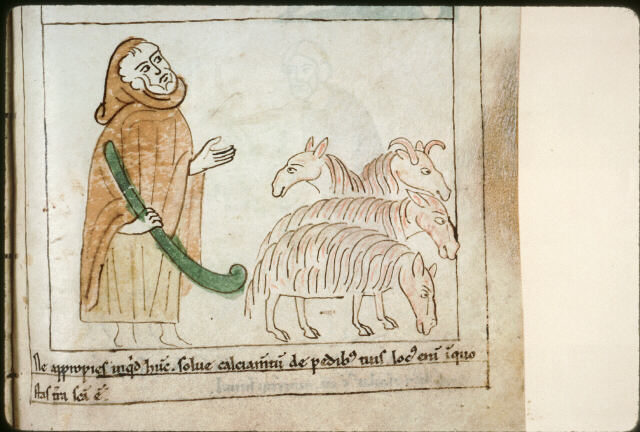
Bibl. Municip. d’Amiens, ms. 0108, f.041
In France as in Albion, Charles V will proscribe the soule, for two reasons, on the one hand of course because of the reports that are made on the violence and the physical damage caused by the soule, but especially, for him, it turns the people away from the bow and crossbow training that they had brought back to the taste of the day, thus justifying the defense of the kingdom.
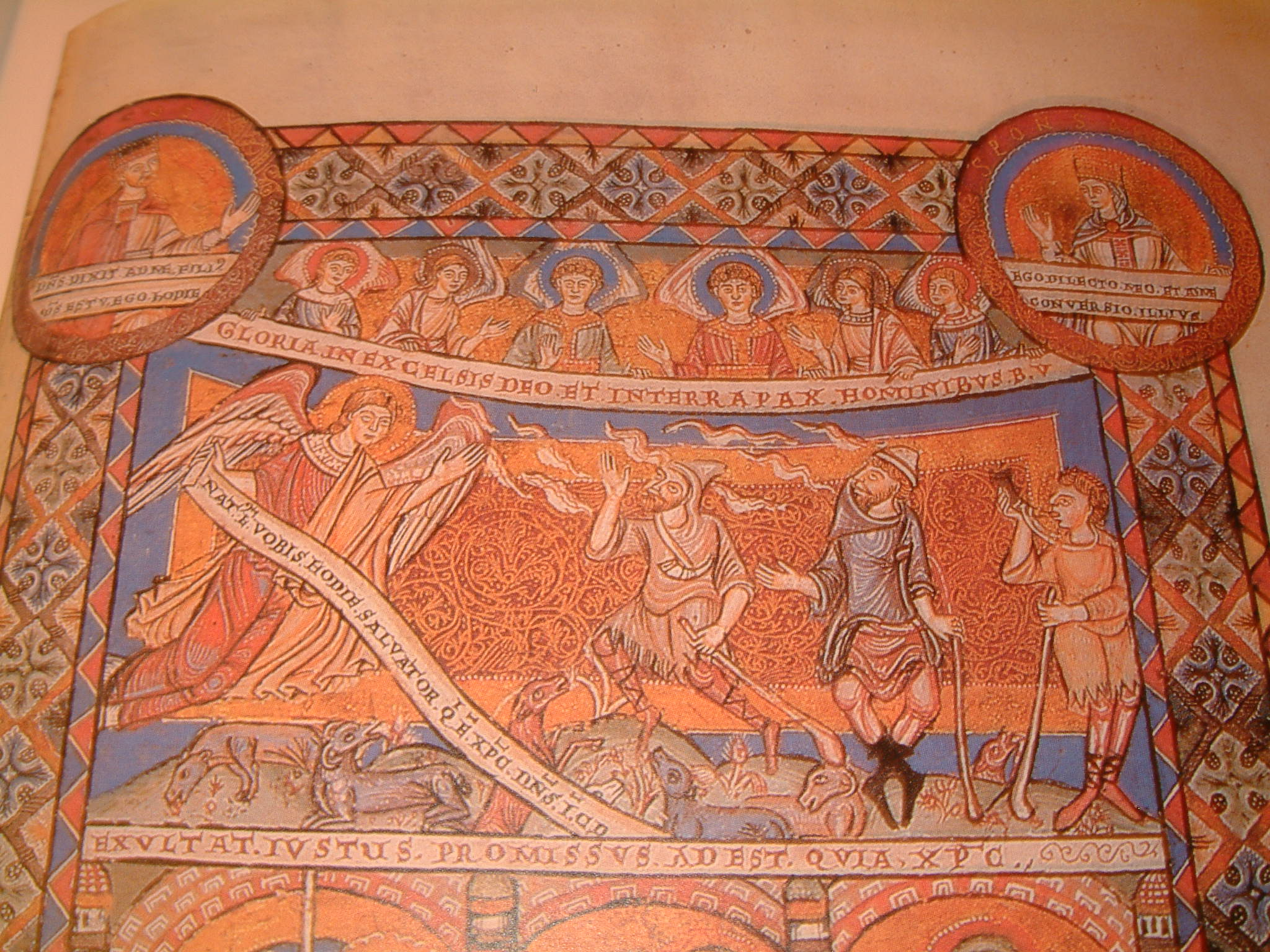
Evangéliaire d’Henri le Lion, 1187-1188
There were no real rules in this game, moreover the majority of the striking people could not read or write, but the oral tradition imposed some guidelines of games.
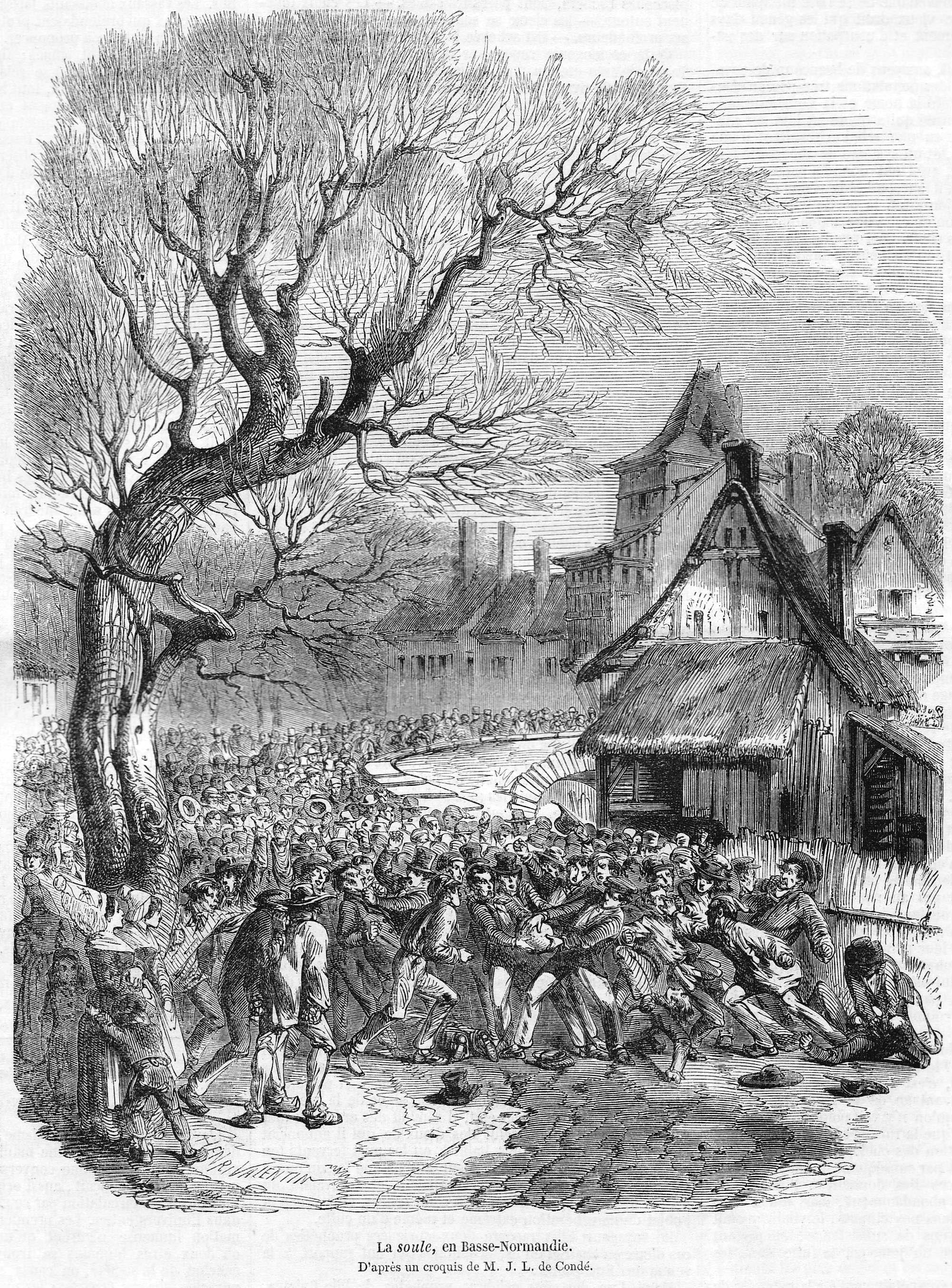
The soule in Lower Normandy in 1852 - in „L'Illustration” February 28, 1852
The rules were very changeable. One of the forms of the game was similar to the current golf, while others were closer to the hockey. This last version of the collective sport is practiced in Brittany until the 19th century, and in Normandy until the end of World War II. The last oral messages came from Cotentin (1943 Bricquebec (Cotentin) and later 1945 in Saint-Vaast (Cotentin).
Formerly, this sport was mainly cultivated from Christmas to the day of Saint. John, during the patron saints and during the carnival.
There are links of this sport with ancient Roman sports (harpastum), then calcio florentin in Quattrocento Italy, Scandinavian (knattleikr) or hurling (renaissance from the beginning of the 20th century) and Irish Gaelic football, Scottish shinty, but also with more modern or less traditional sports : American and Australian football, Canadian Lacrosse.
This sport is the theme of the film "La Soule" by Michel Sibry (1989) with Richard Bohringer and Christophe Malavoy. - Description:
This is a sport that involves moving the ball to the place marked as the goal. Two teams have the same goal (place the ball in a specific place), and their composition had no defined limits (originally teams consisted of all important men from two or more villages / married and not married). The game was started with the ball throw of the last bride of the year), and the ball can move in all directions. We have no other information about any additional rules. In short, it would be a medieval version of hockey.
He who held the ball could only be attacked by one person at a time and it was forbidden to hit under the belt. It was the rural game par excellence, which requires no particular terrain.
We play on the village square, a field, a clearing or on the banks of a river. Natural obstacles such as hedges, ponds and streams or small walls are small supplements that add flavor to the game.
Many people could play: adults, children 6, priests (for example, Archbishop Rouen Eudes Rigaud (around 1205-1276) was indignant in 1248 by the behavior of his diocesan priests playing in ... It also seems that the players were only men. It is certain that the game is difficult, but violence does not seem to be tolerated.We find several variations of the game of Soule. It was a ball or balloon, either of wood or leather, in the latter case it was furnished with hay, bran, moss or even hair of various animals.
The soule was struck by the hand, the fist or the foot, if it was wooden as mentioned above we used wooden sticks, which gives us already four variants of this game: by hand, with the foot, with the two and to the stick. Each region had its preferences because it was played everywhere in France.
The stick is made of birch branches. The handle is rounded, the part used to hit the ball is flattened.
Balls could be made of wood, sometimes made of leather, filled in the latter case with hay, bran or foam or inflated with air. A ball filled with hay has the advantage of being less dangerous for participants. A wooden ball is easier to use in the game, but it is more dangerous.The main feature of this game is the struggle, often violent between two groups, and the spontaneous and public pleasure of the confrontation. The spice of the meeting could also be the settlement of certain grievances between two villages or small towns.
Soule was the tournament of the poor, with its heroes, its wounded and .... its dead !.
Soule was violent, some texts attest, ecclesiastics called it "this fatal sport", the author Adam de la Halle quotes a certain Robin, who complains to his wife "to have belly tired of the soule of l "Other times" But the violent blows could be dead especially in the Crosse à la crosse, where we report the clash of two teams. - Current status:
The lack of specific rules, organized structure and emigration of people from rural areas contributed to the decline of this sport. The return to la Soule took place in Picardy (traditional games) and in Normandy (with precise rules as part of the school competition, but also as part of the open championships and cup competitions).
Today, this sport is also practiced by scouts and has the name "sioul", with similar rules (two teams and two bases).
Sport under the name La Crosse has been practiced in Normandy since 2001 (Cup and championship since 2005) - especially in the north of Cotentin, in the Caen region, at the end of Caux, in the Risle and Roumois, Jersey. Two teams of 4 to 6 players are playing. The ball should be in a goal called viquet, located on the edge of the playing field on both sides. - Sources of information :
B. Merdrignac, Le sport au Moyen-âge, Presses Universitaire de Rennes, 2002
Jean-Jules Jusserand, Les sports et jeux d'exercice dans l'ancienne France, Paris, Plon, 1901, « Paume, soule, crosse et leurs dérivés », p.232-326.
Jean-Michel Mehl, Les jeux au royaume de France du XIIIe au début du XVIe siècle, Paris, Fayard, p.74-75
Madeleine Foisil, Le Sire de Gouberville : un gentilhomme normand au XVIe siècle, Paris, Flammarion 1986
J. F. Mehl, Les Jeux au royaume de France, doctorat d'État, Paris, université de Nanterre.
Christian Pociello, Sports et sciences sociales : histoire, sociologie et prospective, éditions Vigot, 1999
Paul Dietschy, Histoire du football, Perrin, 2010,
Joseph Mercier, Le Football, Que sais-je ? No 1195, Presses universitaires de France, 1966
L. Gougaud, La soûle en Bretagne et les jeux similaires du Cornwall et du Pays de Galles, Annales de Bretagne et des pays de l'Ouest Année 1911 27-4 pp. 571-604 (https://www.persee.fr/doc/abpo_0003-391x_1911_num_27_4_1374)Video:
https://www.youtube.com/watch?v=3oMGvGkJX54
https://www.youtube.com/watch?v=DCjjUN4A1fYSource of photos used in this article and gallery:
https://historiemedievali.blogspot.com/2017/03/la-soule-un-antenato-di-calcio-e-rugby.html
https://twitter.com/histedquarterly/status/1421513030924386311 - Gallery:
- Name of sport (game): Lakhtaoba
- Name in native language: Lakhtaoba
- Place of practice (continent, state, nation):
Georgia
- Sources of information :
Video:
https://www.youtube.com/watch?v=yvBSL5xFlM8
- Name of sport (game): Lancashire Wrestling
- Name in native language: Lancashire Wrestling
- Place of practice (continent, state, nation):
Lancashire wrestling (Catch-as-catch-can) was a folk freestyle wrestling culturally unique to the residents of East Lancashire, England. Historically, it was practiced on the territory which now includes Greater Manchester, as well as Blackburn, Burnley, Pendle, Rossendale and etc. Traditionally, those areas were known as Salford (South) and Blackburn (North) Hundreds of Lancashire County. This wrestling style was also popular among the residents of the places bordering with those areas namely Stockport, Stalybridge, Dukinfield, Hyde of Cheshire, Glossop, Marple Bridge, Woodhead of Derbyshire, and Saddleworth, Huddersfield, Halifax, Bradford, Batley, Dewsbury of West Riding, Yorkshire. The major Lancashire Catch-as-Catch-Can towns listed from West to East were Wigan, Bolton, Bury, Middleton, Rochdale, Oldham, Ashton-under-Lyne.
- History:
Traditionally, Lancashire folk wrestling amateur competitions (wrestling for love) were held during the local folk and religious festivals, such as Wakes week (Rushbearings), May Day, Easter, Whit Monday, Shrove Tuesday, even weekly markets on Sundays and etc. The challenge matches were usually played out of curiosity “who is the better man” or for a quarter or a half gallon of beer. The earliest semi-amateur eliminations tourneys were wrestled for the “trophy pig” or a silver watch.
Professionalism in Lancashire catch wrestling was introduced in the 1820s and since then this style of wrestling was often referred to as a Catch-as-catch-can after the Lancashire fashion. The majority of professionals were recruited from the local colliers, and the most skilled of them were called the “black diamonds.” The wrestling matches between the champions of Lancashire towns of Bolton and Oldham were the earliest known Lancashire Catch Wrestling Derby. The first written ruleset of Lancashire catch wrestling was issued in 1856 by the proprietor of Snipe Inn Grounds (Audenshaw, Lancs) Mr. Nelson Warren, aka the Snipe Inn Rules. During the early stage of the Era of Professionalism the main center of catch wrestling was established in Ashton-under-Lyne, Lancs the town which produced the greatest number of champions in the 1860s aka the Golden Era of Catch Wrestling. During that time the first official titles in the form of “challenge trophies” were introduced in catch wrestling. The most prestigious among them were 9st championships: the Copenhagen Grounds Silver Belt (Newton Heath, Manchester) and the Snipe Inn Grounds Gold Cup.
In the late XIX century the epicenter of catch pro wrestling moved to Wigan, Lancs. This town which gave birth to so many generations of top-notch catch wrestlers maintained its superiority in the XX century as well and is known among the fans and practitioners of catch wrestling as the “Mecca of Catch-as-catch-can.”In the 1870s-80s the Lancashire Wrestling Association (LWA), which was established in 1875/76, was running the annual championship tourneys for professionals at the Grand Circus on Peter-street, Manchester. The founders of that organization were former owners of the famous sporting venues (grounds) of the city of Manchester and the surrounding areas. The LWA competitions were governed by the Manchester’s “Sporting Chronicle” Rules (evolved version of the original Snipe Inn Rules) which soon became standard catch-as-catch-can rules in East Lancashire and remained as such for decades. During that time the following official weight classes were introduced in Lancashire catch wrestling: 116lb, 126lb, 138lb and 154lb. Just like in the 1860s the most prestigious and “competitive” weight division was the 9st championship.
In 1899 Lancashire catch wrestling finally conquered London, the capital of Empire. The open to all British men tourney was held at National Athletic Grounds, in Kensal Rise, London during the Easter holidays. The championships were promoted in two weight divisions: middleweight (12st limit) and lightweight (10st4lb limit). Joe Carroll of Hindley, Lancs won the middleweight tourney and was proclaimed the first official British champion wrestler and became the holder of the magnificent gold and silver belt emblematic of that title. The lightweight championship was undecided.
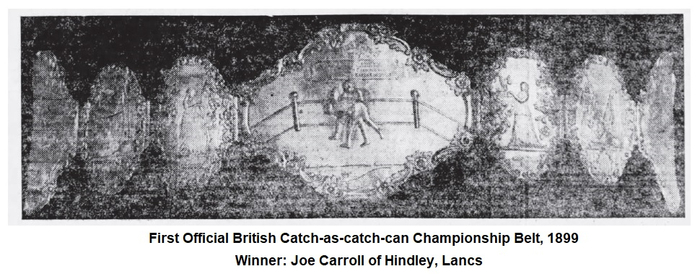
List of the most famous XIX century pro Lancashire catch wrestlers by decade: 1820s/30s John Rowland of Bolton, William Buckley (Trout) and John Holt both of Oldham; 1840s/50s Adam Ridings (Dockum) of Bury, James Matley (Barrel) of Ashton, George Swithenbank of Saddleworth, undefeated heavyweight champion William Swann of Ashton, as well as champion heavyweight boxer of England Sam Hurst of Stalybridge; 1860s the best pound for pound catch wrestler of XIX century Teddy Lowe of Whitworth, John Meadowcroft and David Bentley both of Bury, William Schora, Frank Robinson, John Massey, Joseph Newton (Teapot) all from the Ashton areas; 1870s Edwin Bibby of Ashton, John Lees, John Butterworth (Dockum) both of Oldham, undefeated heavyweight champion William Snape (Dipper) of Bolton, John Tonge (Eckersley), Joe Acton, William Moullineux (Sellars), Miles Sweeney all of Wigan; 1880s/90s Abraham Travis (Ab-o-Wags) of Oldham, James Faulkner, Isaac Smith, William Winstanley (Soap), Tom Connor, Charles Green, Tom Jones (Burgy Ben), Joe Carroll, James Morris (Stockley) all from the Wigan areas, Tom Clayton (Bulldog) of Bolton, James Mellor, Jack Smith both of Stalybridge, Sam Moores of Salford.
The transformation of professional Lancashire catch wrestling into a present-day sport occurred during the so-called British Wrestling Boom Era in the 1904-1910. National Amateur Wrestling Association of Great Britain (NAWA) already existed (est. in 1904) but their wrestling, though also being called catch-as-catch-can wasn't after the "old Lancashire fashion", it was a style which originated in London. Since 1904 NAWA Catch-as-catch-can Rules (pinfalls or a referee decision based on points in case the back fall wasn’t achieved) were generally accepted by both amateurs and professionals of Great Britain. During that era all catch wrestling contests (for both amateurs and professionals) in East Lancashire were governed by the updated version of the Manchester’s "Sporting Chronicle" Rules which were in harmony with the current NAWA Rules.
Among the most famous pro Lancashire catch wrestlers of the British Wrestling Boom Era were: Harry Mort of Oldham, Tom Rose of Bolton, Willie Collins, Jack Carroll (nephew of Joe Carroll), Jack Brown, William Charnock, Jim Foster and Bob Berry all from the Wigan areas, Job Shambley of Westhoughton, Peter Bannon of Burnley, Jack Winrow of Heywood.
The true revival of the catch wrestling in East Lancashire happened in the 1920s during the glorious era of British amateur wrestling. Lancashire County Amateur Wrestling Association (LCAWA) was established in October 1923 and remained a member of NAWA till April 1927 when a decision was made to expel them from affiliated membership for promoting “their own championship titles.” The best among the LCAWA champions, holders of the challenge gold and silver belts also became British Amateur Wrestling Champions. The greatest of them was a 9st champion Joe Reid of Leigh, Lancs, a collier by trade, he held 6 British titles for 5 consecutive years between 1930 and 1935 inclusively, and represented Team Great Britain at 1932 Olympic Games in Los Angeles, USA. Reid was "Teddy Lowe of XX century" and was considered among the best and most scientific pound for pound catch wrestlers of the modern era from East Lancashire. Despite LCAWA’s membership in NAWA was discontinued they didn’t stop promoting and holding their own amateur tourneys (titles) in East Lancashire till mid-1930s. George Gregory of Bolton who during his amateur years was LCAWA champion (welterweight and heavyweight divisions) later became a world-class pro wrestler, the British All-in wrestling heavyweight champion.
In order to popularize professional combative sports among local men in 1930 the Wrestling and Boxing Comrades’ Association (W&BCA) was established in Wigan, Lancs. The chairman of W&BCA was a former pro wrestler and famous rugby coach T. McCarthy. Among the associates of that organization were legendary Joe Carroll and famous Billy Riley, who was a father of the modern Wigan catch wrestling (“Snake Pit” Catch).
After WW2, the British Amateur Wrestling Association changed the name “catch-as-catch-can” to “freestyle” wrestling. It was the beginning of the modern era of amateur catch wrestling in Great Britain. The greatest representative of that generation was ten-time British Champion Herbert Hall of Oldham, Lancs.
The origin of Lancashire catch wrestling goes all the way back to the 1300s. Outside the area of East Lancashire a wrestling style which allowed catch-holds of any part of the person’s body as well as the ground wrestling was unknown in Medieval England. Those two major features of Lancashire catch wrestling were of the Continental origin. The German folk wrestling style called “Bauern-Art Ringen” (wrestling after the farmers’ fashion) had no limitations regarding the holds and featured ground wrestling. Variations of this style of wrestling were popular among Germanic people on the Continent during Middle Ages.
Ironically, the English verbs “to wring” and “to wrangle” and German words for wrestling “Ringen” and “Rangeln” share origin. A variation of Ringen freestyle wrestling was brought to East Lancashire by the immigrants from Flanders, the textile workers aka the “Flemish weavers”, who were adepts in that particular style of wrestling. In Netherlands and Flanders this freestyle wrestling was known as Stoeijen (to touse, to tangle, to scuffle, to handle roughly). The etymology of the word Stoeijen explains the original rules of that wrestling game. The Dutch Soeijen, Flemish Stuwen/Stouwen, German Stauen, and Old English Stowian (the modern English verb “to stow” is derived from this word) basically meant to hold back, to restrain, to block or to suspend from any movement.
The first Flemish immigration to East Lancashire goes all the way back to the XIV century. The earliest Flemish weavers arrived to Bolton, Lancs in 1337. That is why the rough Lancashire up and down style of wrestling was often called the “Bolton Method.” Flemish immigration reached its peak during the persecution of Protestants in Spanish Netherlands in the XVI-XVII centuries. During the era of religious wars in Europe, besides Flemish, the German and French Protestant textile workers also fled to the areas of East Lancashire and West Yorkshire. Arrival of those Continental weavers largely influenced the growth and rise of textile industry in that region of England. The variations of Ringen which were practiced by Flemish people as well as other immigrants from the Continent merged with English folk catch-hold wrestling style and over time evolved into a new unique wrestling style the Lancashire Catch-as-catch-can.
Since the times of the English Civil War (XVII century) in East Lancashire and West Yorkshire the most common way of resolving disputes between two men was to have a fight after the Lancashire fashion. This fighting style was known as Lancashire up and down fighting, or purring. It usually was described as a combination of “wrestling, throttling, and kicking.” The best purrers of Lancashire came from the Rochdale areas.
The up and down fighting match featured a wide variety of brutal, non-wrestling tactics and was an “all-in wrestling” affair. Lancashire fighting was a degenerated form of up and down catch wrestling. In that sport fighters appeared in the ring stripped to the waist, wearing a loin-clothes and a pair of spiked clogs. The wrestling skill was a decisive factor for winning the up and down fighting contest. According to the rules of Lancashire up and down fighting the victory was awarded only on either “submissions” (usually a strangle hold, a hang) or “unable to continue” condition. The defeat had to be admitted verbally, or by raising the hand. Despite being called a fighting style the Lancashire fighting often didn’t allow punching with the fist during the matches.
Professionalism (prize ring) was introduced in Lancashire fighting at the very early stages of its existence. Before pro Lancashire catch wrestling ring was established up and down fighting was the only professional combative sport of local men. Due to the great number of deaths which occurred during up and down fights this combative sport became illegal in the 1820s. Because of that up and down fighting prize ring was soon replaced with the pro Lancashire catch wrestling. After the introduction of professionalism into Lancashire catch wrestling up and down fighting slowly ceased to exist and by the end of the XIX century it became extinct. Most of the professional Lancashire catch wrestlers of the 1830s and 1840s generation had up and down fighting background. All first pro catch wrestling stars were former purrers.
Notably, the transformation of up and down catch wrestling style into an “all-in wrestling” (fighting) style was happening on the Continent as well. German rough-and-tumble style of wrestling and fighting combined called Raufen had a lot of similarities with Lancashire up and down fighting. Similar evolution also occurred in Netherlands, Flanders and France.

- Description:
Historically, there were two modes of Lancashire catch wrestling: the standing freestyle (“wrossle for a thrut”, wrestling for a throw) and the up and down freestyle. In the former style the goal was to give a back fall (sometimes just like in other English folk wrestling styles it was substituted with 3 falls on any part of the body except hands, knees and feet) from the standing position (flying fall) with or without attacker falling down himself, and in the latter the wrestling match continued on the ground until the fair back fall (rolling fall or pinfall) was achieved.
The original up and down Lancashire catch wrestling was basically Dutch/Flemish Stoeijen. In that style to pin adversary wasn’t enough and the wrestler who achieved a dominant uppermost position had to keep his man immovable (captured) under him for the previously agreed amount of time or making him admit his defeat verbally or by raising his hand.
The two original modes of Lancashire catch wrestling perfectly correspond to the “Half Wrestling” (Halber Ringkampf) and “Full Wrestling” (Ganzer Ringkampf) conditions of German folk freestyle wrestling Ringen. In Netherlands and Flanders those two modes of wrestling were known as Neergooi (throwing someone down) and Ondergooi (throwing someone down and keeping him underneath) respectively.
In Lancashire catch wrestling the wrestlers, after shaking hands in a sign of fair-play, started their match on the “green sward” at a distance from each other carefully looking for an opening and then suddenly attack, rushing into their adversary. Often they would snatch one another by the hands intertwining their fingers and using all their strength will try to force their opponent down to his knees. Another common start was to catch-hold adversary by the back of his neck. By proceeding this way they would close and break until the proper close quarter clinch hold (hug) was achieved. This wrestling style was a hand-to-hand combat. Wrestlers were allowed to take any hold of their opponent’s body above and under the waist and switch holds as often as they pleased in order to achieve the advantageous hold which led to a throw. The use of legs and feet for throwing (hooking and tripping respectively) was allowed but it wasn’t favored. Instead the “lift and throw” technique dominated that style. This freestyle wrestling featured such techniques (holds and throws) as various Headlocks, Fireman's Lift and Crossbuttocks (both versions, arm around the neck and arm around the body) as well as different kinds of Nelsons (both ways, from the standing position and on the ground). Throws which were given from the leg attacks were mostly the Double Leg and the High Crotch (single leg attack) lifts. In par-terre a various techniques were applied from both the front and behind of the opponent.
The objective of the wrestling match after the Lancashire fashion was to give opponent a fair back fall, the back fall when both shoulders touched the ground simultaneously. If the victory wasn’t gained from the standing position the struggle continued on the ground until one of the two achieved a fair back fall. All kinds of back falls counted, namely quick falls (flying falls and rolling falls) and pinning falls. The Lancashire wrestlers’ attire was limited to shorts (originally drawers) and socks (originally spiked pumps, hob-nailed light shoes which were worn in order to prevent slippery).

According to the above mentioned Snipe Inn Lancashire Catch-as-catch-can Rules, just like in the old Lancashire up and down fighting neither party could use resin or be rubbed with pernicious (ingridious) drugs or grease of any description. All foul acts or willful brutality, any unmanly techniques and tactics of the past (atrocities which were common during the up and down fighting contests), namely hanging (putting on the hang) or throttling, kicking, as well as head-butting, biting, gouging and scratching and etc. were strictly prohibited. Putting someone in a hold was allowed not for delivering the punishment to make the opponent quit the contest (as it was in up and down fighting) but for the sole purpose of achieving a fair back fall (flying fall, pinfall, rolling fall). The Referee had to stop the match if he saw a wrestler applying any dangerous holds on another wrestler for the purpose of willfully hurting, maiming him or to make him quit.

NOTE: this painting portrays a final contest of the Nudger Sports’ Lancashire Catch Wrestling Tourney, 1844. James Buckley of Middleton, Lancs defeated Adam Ridings of Bury, Lancs.
- Current status:
Currently the Lancashire catch-as-catch-can wrestling in its original folk wrestling format is not practiced anymore, but instead a wide variety of pro catch wrestling styles which evolved from it or were inspired and influenced by the Lancashire wrestling can be found all around the world.
- Sources of information :
The summary on Lancashire wrestling by Ruslan C Pashayev, based on his book “The Story of Catch” (2019).
- Name of sport (game): Lancio del maiorchino
- Name in native language: Lancio del maiorchino
- Place of practice (continent, state, nation):
Novara di Sicilia, Italy
- History:
The Majorcan game was very popular in the past in the province of Messina, especially in the Nebrodi and Peloritani areas. Today it survives only in Novara di Sicilia, where time seems to have stopped and whose inhabitants, very attached to traditions, usually practice it. The first "Majorcan" began to tumble through the characteristic streets of Novara di Sicilia probably in the first thirty years of the 1600s, a time when pedestrians and animals began to walk the road that goes from the beginning of the descent of the Chiesa Matrice to Piano Don Michele. It is thought that the Majorcan game could not have existed before due to the difficulty of practicing it in the narrow Via del Passitto, characterized by dead ends. Among the curious stories that pass on the alleged origins of the Majorcan game, there is the one according to which it seems to be a transformation of the game of the "ruzzola", which consisted of a wooden disk thrown and rolled through the streets. But those who tell it add that this transformation was nothing more than the result of a fun carnival bet between shepherds and producers of the delicious cheese to prove who had produced the best quality cheese: if the shape, in the "tumbling", had broken meaning that that product did not have the qualities of a good Majorcan.
- Description:
In the Novara dialect, "a maiurchèa" is a form of local pecorino cheese (from 10 to 12 kilograms with a thickness of 10 - 12 cm. And with a diameter of around 35 cm.) That is launched with the mazzacorto (lazzàda 3 - 3.50 m) wrapped around the circumference.
The Launch of the Maiorchino is a game of skill between teams which consists in launching a form of Maiorchino (a local pecorino cheese weighing 10 kg and aged for eight months). The winner is whoever completes the established course with the least number of throws. The launch is carried out with the Lazzada, that is a shoemaker's twine of about 3 meters.
It is a game that derives from the peasant and pastoral world of the province of Messina at the beginning of the 1600s, when the cheesemakers rolled the wheels in the street to control the maturing of cheeses.Competitors compete in the tournament using cheese wheels weighing from 10 to 18 kg. The tournament takes place on the traditional route from via Duomo to via Bellini and Piano Don Michele. The unique tournament consists in rolling a wheel of mature formaggio maiorchino along a path that winds for over two kilometers along the narrow streets of the town. 16 teams of three competitors regularly play, starting from "cantuea da chiazza" and reaching a goal: "a sarva". It is launched with a "lazzada" of about 1.00-1.20 meters, which allows the launch greater strength, speed and precision. The winner is whoever arrives first with fewer shots to hit "a sarva".
The game has precise rules to respect, among these: each team must indicate its own captain who can confer with the referees to possibly assert their reasons; each team must equip themselves with a "lazzada" to be twisted around maiorchino cheese for the launch; the team that is drawn first begins the game (touch); each contender must throw maiorchino cheese from the marked point, without any run-up, using the support foot ("pedi fermu"); in the event that maiorchino cheese breaks during the match, he will be replaced with another form of maiorchino cheese of equal weight and the previous throw will be considered valid; at the end of each match maiorchino cheese must be returned to the Olimpia club (the association that organizes the tournament and maiorchino cheese festival).
The event ends with the ritual "Sagra del Majorchino", with tasting of ricotta, tuma, maiorchino cheese and, last but not least, with a mega maccheronata with pork sauce whitened by abundant Majorcan, a typical local pecorino cheese.The Maiorchino
It is a raw hard cheese; it is produced with raw whole sheep's milk sometimes mixed with goat, the traditional equipment is the "quarara", the "jug", the "Garbua" (wooden fascera), the "mastrello" (wooden board), the "fascedde "; peculiarity of the processing is represented by the drilling of the dough, with a thin iron rod called "menaccino", which favors syneresis; after two days the cheeses are dry salted for 20/30 days. The seasoning takes place in stone buildings, sometimes underground, cool and humid, equipped with wooden shelves. It can last up to twenty-four months. The shape is cylindrical with flat or slightly concave faces, the rind is amber yellow tending to brown as it ages, the paste is white tending to straw yellow, the consistency is compact. The weight can vary from 10 to 18 kg. In the mouth, the herbaceous, floral and fruity aromas characterize this cheese with a strong and spicy taste, especially if aged.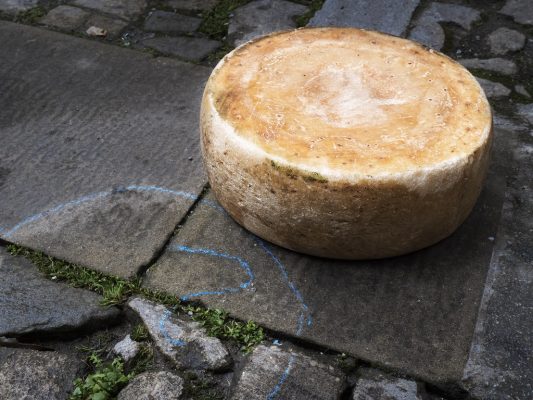
Game Rules
Art. 1 The game consists in throwing il maiorchino along the path that goes “from cantuèa da Chiazza to sarva du chièu don Michèri” (almost 1 km);
Art. 2 Each team must report, before the start of the match, their captain, who can confer with the match judges to assert their reasons "in case ... there were any";
Art. 3 The team that is drawn first begins the game (toccu);
Art. 4 Each player must throw il maiorchino from the marked point, without any run-up, using the support foot (pèdi fermu);
Art. 5 The team that first reaches the point of arrival (a sarva) with the same number of throws (corpi) wins. In the event of a possible appendix, continue, as usual, along the road that leads to the Corte Sottana mills.
Art. 6 In the event that il maiorchino breaks during the match, the point where the largest piece will stop will be marked and it will be replaced with another form of il maiorchino of equal weight;
Art. 7 For anything not provided for in this “regulation”, the atavistic and ancient rules of the “Game of the Maiorchino in Novara” remain in force; - Current status:
In Novara di Sicilia it is still practiced, with a lot of enthusiasm and a lot of participation, following the usual, old and few rules that govern the game.
Unfortunately, today il maiorchino is produced in limited quantities, also because the sanitary regulations are quite complicated and therefore many shepherds have given up the production and direct sale of this cheese. Traditional production techniques are complex and require time, experience and care, and seasoning is long and expensive. Also thanks to the lancio di maiorchino competition, the local heritage is preserved, which allows us to tell about this old tradition in an original way, respecting it and preserving the memory of it.
- Importance (for practitioners, communities etc.):
Viewers have a keen interest in taking the side of one or the other challenger; there is an atmosphere of elation and exaltation, rivalry and competition, comparisons and preferences, forecasts and predictions, while in the hustle and bustle of people, supporters of one or the other side, you can hear the memories of the "famous" throws of players who went down in the history of the "Maiorchino game", come to life. As if browsing an ancient dictionary, words are pronounced in different languages as you play. Hear archaic words and accents; these are words that are not repeated throughout the year, but only on the occasion of the Novara winter festival.
Tutaj są niektóre z nich:
Preliminaries: "u touchu" - "scratch a maiurchèa i strìghila bora o muru" - fagìdivi fa a lazzàda 'nciàda du scarpàu "-" guàrdici u strittu "-" mòglia bora a maiurchèa ".
Methods, causes and effects of the launch: "mòglia bora a lazzàda" - strìngila bella ditta "-" schìccila a màu dritta "-" daj nam na runcàda "-" lanzila o spìgu da cappillitta "-" mèttici u strittu p'a cariètta " - "mèttici un giru e menzu i lazzada" - 'mbuccàu "-" a' mbusciuèu "-" a cattafuccàu "-" si ni niscìu i to lazzu "-" si smugliau "-" si cuglìu "-" sarvàu " .
Notices: "guardèmmu" - "i ghemmi".
Stages along the way: „spizzigàu u spigu da casa i Paradùri” - „mbuccàu o spigu da Cappillitta da Madonna du Carmu” - sprusciàu cu muru da casa i don Gneziu Sufia „-” pigliàu a scinnada da Matrìcàu „-” si daventi o buccu i vallo Faànga "-" ci spunnàu a porta ò Pastàu "-" caràu p'a strada du tiattru e scinnìu 'ntà l'ortu du zì Miccu "-" caràu a San Giorgi a chiappa i Garbàdu "-" tak curcàu 'nto chièu ”-„ si' nziccàu to cattafuccu ”. - Sources of information :
Articles:
https://www.siciliafan.it/sagra-del-maiorchino/
https://www.comunedinovaradisicilia.me.it/il-torneo-del-maiorchino.htmlVideo:
https://www.youtube.com/watch?v=eaD2vsMTHrg
https://www.youtube.com/watch?v=H5XxKAs7iqI
https://www.youtube.com/watch?v=7zERayFDUFAPhoto sources in this article:
https://www.siciliainfesta.com/feste/sagra_del_maiorchino_novara_di_sicilia.htm
https://m.guidasicilia.it/rubrica/un-formaggio-una-tradizione-un-torneo-il-maiorchino-di-novara/3007470
https://togoitalia.it/e7/torneo_e_sagra_del_maiorchino
https://www.insidemessina.it/index.php/component/content/article/11-cultura/59-il-torneo-del-maiorchino.html?Itemid=101
http://www.corrieredeinebrodi.it/feste-e-sagre/territorio/sagra-del-maiorchino.html
https://www.siciliafan.it/gioco-del-maiorchino/
https://siciliadascoprire.altervista.org/il-gioco-del-maiorchino-a-novara-di-sicilia/
http://www.solosagre.it/evento/?id=22219
https://tocati.it/novara-di-sicilia-il-lancio-del-maiorchino/ - Gallery:

